A possible [unmarked] Revolutionary War Continental Army Cemetery in downtown
Trenton, Mercer County, New Jersey
April 2023
by Daniel M. Popek (Army Brat and Author; Descendant of an enlisted soldier who served six years in Rhode Island's Continental Line)
In Association with "Friends of America's Continental Line (Revolutionary War)" Facebook Group
History Introduction
The French and Indian War Barracks at Trenton, New Jersey, constructed in 1758, was used as quarters for units of the Continental Army during
the American Revolutionary War. Trenton is most famous for the British and Hessian occupation and General George Washington's successful
assault on the Hessian Brigade that was garrisoned in the town in late December 1776 at a critical moment in the American Revolution. The use
of the Barracks as an auxiliary hospital and the death of some known sick and wounded Continental soldiers is the purpose of this web page. Where
were these American heroes buried at? None of the Continental soldiers introduced on this page were recorded as having been buried in the local
Trenton church cemeteries [Saint Michael's Church, Friends Meeting House, First Presbyterian Church]. The absence of Trenton church cemetery
soldier burial records and any known "Strangers Burial Grounds" in the small town suggest that these soldiers could have been buried in a "lost"
military cemetery in the land south of the barracks. Modern technologies, including cadaver dog searches and ground penetrating radar surveys,
could potentially locate this suspected "lost" Continental Army cemetery of the Revolutionary War.
In late 1776 and early 1777, smallpox had broken out in the Philadelphia area. General George Washington wanted his new Continental Army recruits
for 1777, who were to enlist for three years or "during the war" [duration of the war], to get innoculated for the smallpox. Dr. Bodo Otto of
New Jersey was ordered to set up a smallpox innoculation hospital at the Trenton Barracks in early 1777 [Mary C. Gillett, Ph.D., "The Army Medical
Department," p. 75]. Likely there were some soldiers who died during this early period at Trenton and additional research needs to be done. The
British campaign against Philadelphia occupied much of the Continental Army's attention for 1777, and two large battles were fought at Brandywine
Creek and Germantown, Pennsylvania. Some of the wounded American soldiers were sent to the Trenton Barracks for treatment, and a few from Colonel
John Crane's Massachusetts Continental Artillery Regiment are known to have died of their wounds [who are listed below].
Some of the known Doctors who served temporarily at the Trenton Barracks under Doctor Otto from 1777 to 1778 included Doctor David Jackson [1747 - 1801;
David later became Quartermaster General of the Pennsylvania Militia in the late 1700s] of Pennsylvania (see a transcript of his original 1777 letter
below), Surgeon's Mate John Dickinson of the Pennsylvania State Navy (see his Federal Pension File S991), and Surgeon's Mate John Keemle of Philadelphia
[3rd Virginia Continental Regiment; see his Federal Pension File S5652, particularly page 98]. After the British had captured Philadelphia in late September
1777, sick American soldiers were gradually moved away from the Philadelphia and Trenton areas to "safer" locations in the countryside [Mary C. Gillett, Ph.D.,
"The Army Medical Department," pp. 79-83].
New Jersey Governor William Livingston wrote in a letter to Henry Laurens on December 25, 1777: "...In the Hospital at Princeton, we have lost
from the above Causes [lack of blankets and medical supplies] from 4 to 5 [soldiers] per Diem out of Five Hundred [sick soldiers], which out of
the whole Number now in our Hospitals [in New Jersey and Pennsylvania] is 50 a Day, and which should the same Number be kept up till the first
of April would amount to 4500 [soldier deaths]." [Carl E. Prince and Dennis P. Ryan, editors, "The Papers of William Livingston," Vol. 2, p. 145].
Dr. Bodo Otto was sent to the Continental Army Hospital at Yellow Springs near Valley Forge, Pennsylvania in spring 1778 [the unmarked American
Continental Army Cemetery at Yellow Springs still has not been located to date] [Marcy C. Gillet, Ph.D., "The Army Medical Department," pp. 87-88].
After the Battle of Monmouth, New Jersey, some sick and wounded American soldiers were sent to the Trenton Barracks to recuperate [Ibid., p. 99].
Sick numbers at Trenton declined from 1779 through 1780 [Ibid., pp. 110-111].
In early 1781, General Lafayette commanded a detachment of hand-picked Light Infantry soldiers from the American Grand Northern Army in the West Point,
New York area [one of my ancestors was a Sergeant in the Light Infantry Company of the Rhode Island Regiment (Continental); studying his story is how I
learned several unit details]. General Lafayette's Light Infantry Brigade passed through Trenton, New Jersey before embarking on vessels down the
Delaware River to Christiana Creek for an overland march to Head of Elk [Elkton], Maryland. These Continental Light Infantry soldiers would spend most
of 1781 in Virginia. Unfortunately, some of these Continental soldiers would die of sickness in various hospitals from Virginia to New Jersey.
In the summer of 1781, the French Army and a large detachment of American Continental soldiers marched through Trenton, New Jersey to engage
Lord Cornwallis' British troops at Yorktown, Virginia. The siege at Yorktown was successful, but what many Americans don't know is that
a significant smallpox epidemic broke out amongst the American and French soldiers who served in Virginia. In November 1781, many of
the American regiments and Light Infantry detachments were ordered back to the West Point, New York area. With sickness breaking out,
a chain of military hospitals was established on the march route from Williamsburg, Virginia to Trenton, New Jersey. The following is
a brief summary of known military hospitals and the doctors that supervised the particular hospital (if known).
Williamsburg, Virginia
A flying hospital was established immediately behind the American siege lines at Yorktown, Virginia. A larger American military hospital at
Williamsburg was set up in the abandoned Governor's Palace site, which was burned down in December 1781. Doctors Malachi Treat of New York
City and James Tilton of Wilmington, Delaware supervised the medical hospitals in the Williamsburg, Virginia area. A Continental Army cemetery
was discovered by accident in the Governor's Palace gardens in the 1930s with fairly well-preserved human skeletons. After finding a manuscript
document in Rhode Island which identified the death locations of most of Rhode Island's 1781 to 1782 war dead, I was able to identify the Rhode
Island soldier buried in Grave 156 in Williamsburg because of the unique Rhode Island Regiment uniform buttons discovered in that grave and the
manuscript document. I am attempting to get a U.S. Department of Veterans Affairs monument erected for the Rhode Island soldier, but so far,
Colonial Williamsburg Management has not been cooperative. I have identified some other likely Continental soldiers buried at Williamsburg,
but their specific graves will likely not be identified because of a lack of recovered, distinct military uniform buttons.
Annapolis, Maryland
A military hospital was established at or near Annapolis, Maryland in late August 1781 at the Anne Arundel County Poor House, but I don't know
the exact location of the Poor House [any Maryland historians that know the exact location of this building in 1781, please email me below; see
"Journal and Correspondence of the Council of Maryland," Vol. 45, 1780 - 1781, p. 581]. We know from Surgeon (Doctor) Daniel Shute's Journal
that almost 50 soldiers had the smallpox at the Annapolis military hospital on November 29, 1781. It is possible there is a small Continental
Army cemetery in Annapolis, Maryland, but more historic evidence would need to be discovered to try to pinpoint any cemetery in the field.
I know for example Private Daniel Jones of the First Massachusetts Continental Regiment [serving detached in Captain Luke Hitchcock's
First Massachusetts Light Infantry Company, Col. Vose's Light Infantry Regiment under Lafayette] was sick at the Annapolis hospital facility
and died on December 4, 1781, but I don't know if he had been transferred to the Head of Elk hospital, or died in Annapolis.
Head of Elk [Elkton], Maryland
The American Continental Army Hospital at Head of Elk was established at the Doctor Abraham Mitchell House (still standing), which had been
used as a hospital earlier in the Revolutionary War. Harvard College graduate Doctor Daniel Shute of Hingham, Massachusetts ran the late
1781 hospital and kept a journal of his experiences. Doctor Shute served as the surgeon for Lt. Col. Alexander Hamilton's Light Infantry
Regiment in the Yorktown, Virginia campaign. He returned up the Chesapeake Bay on a coastal vessel and arrived at Elk Landing, Maryland
on November 19, 1781. The next day, Doctor Shute travelled overland to New Castle, Delaware, where he unloaded French Army hospital
stores. On November 22, 1781, Doctor Shute returned to Head of Elk and received orders from Doctor Henry Latimer to run the American
Hospital at the Doctor Abraham Mitchell House. Doctor Shute mentioned in his journal that he treated Ensign Ebenezer Daggett of the
Second Connecticut Continental Regiment during the day of November 24, 1781. Doctor Shute reported in his journal that he was on
continuous hospital duty from November 30, 1781 to January 8, 1782 without any leisure breaks. The hospital was shut down and surviving
patients were transferred to Wilmington, Delaware on February 13, 1782 according to Doctor Daniel Shute.
I created a web page for the suspected Continental Army Cemetery at Head of Elk here.
Wilmington, Delaware
Doctor Henry Latimer [1752 - 1819] of Wilmington, Delaware organized a military hospital at the Wilmington Academy school building downtown
in late 1781. The Rhode Island manuscript document identified 28 known soldiers of the Rhode Island Regiment (Continental) who died at the
Wilmington Academy. Additional historical research by myself and Tom Mercer of Wilmington and Brandywine Cemetery confirmed that there was
a Stranger's Burial Ground existing during the Revolutionary War which was later removed to Wilmington and Brandwine Cemetery in the 1850s.
The sick Continental soldiers who died were most likely buried in the Stranger's Burial Ground. A late 2018 proposal for a new monument in
Wilmington and Brandywine Cemetery to honor the known Rhode Island Regiment soldiers can be found here.
Philadelphia, Pennsylvania
Several Continental soldiers were quartered at the large French and Indian War barracks in the Northern Liberties and some sick troops were
treated there. Another large medical facility was set up at the Pennsylvania Hospital on Eighth Street on the western outskirts of Philadelphia,
possibly run by Dr. Benjamin Rush. Over 60 Rhode Island Regiment soldiers and some other known Continentals died and were buried in "South East
Square," modern day Washington Square which is owned legally by the City of Philadelphia. Unfortunately, our incompetent National Park Service
has taken over management of the Washington Square site (incorporating it into Independence National Park), and they currently refuse to erect ANY
monuments to the several known Continental soldiers that are buried there (even though each Continental soldier who died is LEGALLY ENTITLED to
a U.S. Department of Veterans Affairs monument at a minimum). While they are more than happy to accept several new multimillion dollar buildings
in Independence National Park, our bumbling, deficient National Park Service Management [excepting the N.P.S. Archaeological Staff at Independence]
also refuses to erect a U.S. Department of Veterans Affairs monument for First Lieutenant Oliver Jenckes of the Rhode Island Regiment (Continental)
who was buried in a Presbyterian Cemetery in downtown Philadelphia, which is now the front lawn of the National Constitution Center. While excavating
the deep foundations of the National Constitution Center in the year 2000, our National Park Service quietly removed about 150 eighteenth century
bodies from the northern one third of the old Presbyterian Cemetery. The National Park Service admits there are likely more bodies in the two thirds
of the old cemetery that went unexcavated. Our esteemed National Park Service also refuses to publish any of the technical bioarchaeological reports
concerning the remains that were removed from WE THE PEOPLE's PUBLIC LAND in the years 2000 to 2002. My petition for a U.S. Department of Veterans
Affairs monument for First Lieutenant Oliver Jenckes can be read here.
Some Detail on the American Grand Northern Army Detachments to Yorktown, Virginia [Order of Battle], 1781
Revolutionary War Reenactor John U. Rees of Pennsylvania was one of the first researchers to seriously examine the American Continental Light Infantry
Detachments to Virginia during the 1781 campaign (see citations below). Following up on Rees' publications, I self-published a detailed book on Rhode
Island's Continental Line units in November 2015. It is critical to understand the various detachments that were sent to the South, particularly if a
researcher is trying to identify specific Continental death casualties. What follows is a brief summary of the American Continental Line units that
were sent to Yorktown, Virginia during the 1781 campaign.
Lafayette's Continental Light Infantry Brigade, February 1781
This unit was a provisional Light Infantry Brigade created from handpicked Continental soldiers from Continental Regiments serving in the West Point, New York
area. The Continental Army was reforming in the year 1781 so several new recruits were being added to the regiments in the West Point area. Hence, most
of the Continental soldiers who served with General Lafayette were veterans of the 1777 to 1780 Continental Regiments. General Lafayette marched and sailed
his Light Infantry Brigade to the Chesapeake Bay and later Virginia to monitor and engage British Army units through much of 1781. These American Light
Infantry soldiers also participated in the successful Yorktown, Virginia siege. They returned to the North in very late 1781, but some American soldiers
died of sickness on the journey from Yorktown, Virginia. These deceased soldiers are the ones I am trying to identify.
Major General Marie Jean Paul Joseph Roch Yves Gilbert du Motier Marquis de Lafayette [France] - Commanding Officer
with various Continental Staff Officers and Volunteers, see my book, pages 481 to 485 for details
Colonel Joseph Vose's Light Infantry Regiment [Massachusetts]
Colonel Joseph Vose [1st Massachusetts Continental Regiment]
Major William de Galvan [Continental Officer from France]
1st Massachusetts Continental Light Infantry Company [Captain Luke Hitchcock] [Parent Regiment - Colonel Joseph Vose]
2nd Massachusetts Continental Light Infantry Company [Captain Robert Bradford] [Parent Regiment - Lieutenant Colonel Ebenezer Sprout]
3rd Massachusetts Continental Light Infantry Company [Captain John Fowles (Fowle)] [Parent Regiment - Colonel John Greaton]
4th Massachusetts Continental Light Infantry Company [Captain George Webb] [Parent Regiment - Colonel William Shepard]
5th Massachusetts Continental Light Infantry Company [Captain Joshua Benson Jr.] [Parent Regiment - Colonel Rufus Putnam]
6th Massachusetts Continental Light Infantry Company [Captain Peter Clayes] [Parent Regiment - Lieutenant Colonel Calvin Smith]
7th Massachusetts Continental Light Infantry Company [Captain William White (KIA October 13, 1781)] [Parent Regiment - Lieutenant Colonel John Brooks]
8th Massachusetts Continental Light Infantry Company [Captain John Burnham (Burnam)] [Parent Regiment - Colonel Michael Jackson]
Lieutenant Colonel Jean-Joseph Sourbader de Gimat's Light Infantry Regiment [Massachusetts, Connecticut, Rhode Island]
Lieutenant Colonel Jean-Joseph Sourbader de Gimat [Continental Officer from France]
Major John Palsgrave Wyllys [Connecticut] (Third Connecticut Continental Regiment)
9th Massachusetts Continental Light Infantry Company [Captain William Watson/Captain Thomas Hunt] [Parent Regiment - Colonel Henry Jackson]
10th Massachusetts Continental Light Infantry Company [Captain William Park (Parke)] [Parent Regiment - Colonel Benjamin Tupper]
1st Connecticut Continental Light Infantry Company [Captain Jonathan Heart (Hart)] [Parent Regiment - Colonel John Durkee]
2nd Connecticut Continental Light Infantry Company [Captain Elijah Chapman] [Parent Regiment - Colonel Heman Swift]
3rd Connecticut Continental Light Infantry Company [Captain Roger Welles] [Parent Regiment - Colonel Samuel B. Webb]
4th Connecticut Continental Light Infantry Company [Captain Samuel Augustus Still Barker] [Parent Regiment - Colonel Zebulon Butler]
5th Connecticut Continental Light Infantry Company [Captain Richard Douglass] [Parent Regiment - Lieutenant Colonel Isaac Sherman]
Rhode Island Regiment Continental Light Infantry Company [Captain Stephen Olney] [Parent Regiment - Lieutenant Colonel Jeremiah Olney]
Lieutenant Colonel Francis Barber's Light Infantry Regiment [New Jersey, New Hampshire, Hazen's Regiment]
Lieutenant Colonel Francis Barber [New Jersey] (First New Jersey Continental Regiment)
Major James Randolph Reid [Hazen's Regiment]
1st New Jersey Continental Light Infantry Company [Captain Jonathan Forman] [Parent Regiment - Colonel Matthias Ogden]
1st New Jersey Continental Light Infantry Company [Captain Aaron Ogden] [Parent Regiment - Colonel Matthias Ogden]
1st New Jersey Continental Light Infantry Company [Captain William Piatt] [Parent Regiment - Colonel Matthias Ogden]
2nd New Jersey Continental Light Infantry Company [Captain Jonathan Holmes] [Parent Regiment - Colonel Elias Dayton]
2nd New Jersey Continental Light Infantry Company [Captain Cyrus D'Hart] [Parent Regiment - Colonel Elias Dayton]
1st New Hampshire Continental Light Infantry Company [Captain Josiah Munro] [Parent Regiment - Colonel Alexander Scammel]
2nd New Hampshire Continental Light Infantry Company [Captain William Rowell] [Parent Regiment - Lieutenant Colonel George Reid]
Colonel Moses Hazen's New York/Canadian Continental Light Infantry Company [Captain Thomas Pry] [Parent Regiment - Colonel Moses Hazen]
Captain Joseph Savage's Continental Artillery Company [Detachment from Colonel John Lamb's Second (New York) Continental Artillery Regiment]
Captain Joseph Savage (Massachusetts)
Three Regiments of Pennsylvania Continental Light Infantry soldiers were added to Lafayette's Command in the summer of 1781 under
Brigadier General Anthony Wayne. After Yorktown, they would join the Southern Continental Army under General Nathanael Greene.
The Grand Northern Army Detachment to Yorktown, Virginia, August to December 1781
Lieutenant General George Washington [Virginia]
Major General Benjamin Lincoln [Massachusetts]
Colonel Alexander Scammel's Continental Light Infantry Regiment [Massachusetts, Connecticut, New Hampshire, Rhode Island]
Colonel Alexander Scammel [New Hampshire] (Colonel Scammel was a strict disciplinarian and was not well liked by his enlisted
soldiers; he was mortally wounded in September 1781 while conducting a reconnaisance on horseback; he died on October 6, 1781; his body
was either buried in the Williamsburg Continental Cemetery or in a Williamsburg Church Cemetery and to date has not been located)
Lieutenant Colonel Ebenezer Huntington [Connecticut] (Third Connecticut Continental Regiment)
Major Nathan Rice [Massachusetts] (Fourth Massachusetts Continental Regiment)
This provisional regiment was formed in early June 1781 after a detached company of the Rhode Island Regiment was assaulted by Delancey's
Loyalist Corps on May 14, 1781 along the Croton River in New York.
Lieutenant Colonel Alexander Hamilton's Light Infantry Regiment [New York, Connecticut] [Formed in August 1781]
Lieutenant Colonel Alexander Hamilton [New York] (The former artillery officer managed to use his old political connections
with General Washington to get this command even though there were other, far more experienced infantry officers available.)
Major Nicholas Fish [New York] (Second New York Continental Regiment)
Washington's Life Guard
First Lieutenant William Colfax [Connecticut]
Continental Corps of Sappers and Miners
Captain David Bushnell [Connecticut]
Second Continental Artillery Regiment [New York]
Colonel John Lamb [New York]
1st New Jersey Continental Regiment
Colonel Matthias Ogden
2nd New Jersey Continental Regiment
Colonel Elias Dayton
1st New York Continental Regiment
Colonel Goose Van Shaick
2nd New York Continental Regiment
Colonel Philip Van Cortland
Rhode Island Regiment (Continental)
Lieutenant Colonel Jeremiah Olney
Hazen's New York/Canadian Continental Regiment
Colonel/Brigadier General Moses Hazen [Canada]
Known and Suspected American Continental Army War Dead at Trenton, New Jersey, 1777 to early 1782
There are surviving American military records of individual regiments from the 1777 to 1782 period, but these records are scattered and
far from complete. During the seven years of research for my November 2015 book on Rhode Island's Continental Line, I came across some
of these records and noted the many individual Continental soldier deaths most of whom were buried in unmarked graves. I visited Trenton,
New Jersey in person and carefully observed the land around the Trenton Barracks site. I reviewed the excellent Hunter Research, Inc. report
on the Petty's Run Archaeology Site west and northwest of the Trenton Barracks. To date, I have discovered no historical evidence of burials
of Continental officers or enlisted soldiers in the Trenton Saint Michael's Church, Friends Meeting House, or First Presbyterian Church
cemeteries. As the three Rhode Island Regiment (Continental) soldiers were men of color, it seems particularly unlikely they would have
been allowed to have been buried in the Trenton Church cemeteries. Thus, the Williamsburg, Virginia model of an unmarked military cemetery
near the hospital facility seems to apply to the Trenton Barracks hospital site.
This list is a preliminary compilation of known American Continental Army war dead at Trenton, New Jersey [it will be updated as new evidence
is discovered] and is far from complete:
1777 to 1778 Colonel John Crane's Massachusetts Continental Artillery Regiment [Battle of Brandywine]
1. First Lieutenant Joseph Andrews, Col. John Crane's Continental Artillery Regiment, Federal Bounty Land Warrant [BLW] 2073-200,
Died November 22, 1777
Joseph was a single man from Essex County (most likely Marblehead) in Massachusetts and was mortally wounded at the Battle of Brandwine.
He was treated at Mrs. Rachel Stille's House in Trenton, New Jersey by Doctor David Jackson and died of a fever and gangrene on November 22,
1777. He left brothers and sisters in Massachusetts who filed the Federal Bounty Land Warrant [see also Massachusetts Soldiers and Sailors
of the Revolutionary War, Volume 1, pages 253-254]. His brother John Andrews [1764 - 1845] became the Minister of the First Religious Society
of Newburyport, Massachusetts.
Transcription of Doctor David Jackson's December 4, 1777 Letter from Trenton to Lieutenant Andrews' Family in Massachusetts [from BLW 2073-200]:
"Sir,
To a mind possesed with the tender feelings of humanity, it is ever painful to be the messenger of sad tidings, but circumstances may arise,
in which we must foregoe every sensation of sympathetic tenderness, and it becomes humanity nay even charity to tell the unwelcome tale. Such,
Sir, is the situation I stand in with respect to you, to whom I am an entire stranger and it is more than probable had ever remained so, unknown
even by name, had not your Son Lieut. Joseph Andrews, who was wounded at the Battle of Brandywine in Pennsylvania, on the 11th of September last,
fallen under my care as a Surgeon. Before you read thus far, your anxious mind full of paternal tenderness, will have anticipated the worst of
consequences, and I need scarcely add, that after suffering much, which he bore with the fortitude and resignation characteristic of a good
Soldier and a Christian, he resigned his breath on the morning of the 22nd November, last. As it may afford you some consolation to know the
particulars of his case; it stands briefly thus - It was near three weeks after your Son received the fatal stroke, before he was brought to the
Hospital at this Town [i.e. Trenton Barracks] and put under my care.
His wound was in the thigh just above the knee, and went pretty deep so as to touch the Bone - at first, as he often told me, it appeared slight,
both to himself and the Surgeon that attended, but in a few days he was seized with a violent Fever, which continued with very little intermission
until his death. The fever was of the most obstinate kind, and eluded all the power of medicine - it rendered his habit of body very bad, and
disposed his wounds to Gangrene and mortification, which in the end proved fatal. You may assure yourself, he had every assistance and necessary
that his Case required after he came to this Town. The Family where he was accommodated were kind to him in the greatest degree; had he been their
dearest Relative, they could not have done more, or expressed greater anxiety for his recovery - had he survived, I believe he would never have forgot
their kindness. His cloaths are yet in the possession of Mrs. Still [Rachel Stille of Trenton, New Jersey], the Gentlewoman where he lodged; I have
wrote to the Camp, desiring the Captain of his Company either to come himself or send some person for them. The Bearer of this is Col. Jarvis a
Relation of Mrs. Stills, who goes to Boston on business; whatever civility you are pleased to show this stranger, that good Lady will take as done
to herself.
I remain Sir your most Obedient Humble Servant,
David Jackson"
2. Matross John Buckston, Captain Jotham Drury's Company, Col. John Crane's Continental Artillery Regiment; Died August 5, 1777;
No Federal Pension
John was from Sutton, Massachusetts and was reported on muster rolls as sick at Trenton, New Jersey until he died on August 5, 1777 [see
also Massachusetts Soldiers and Sailors of the Revolution, Vol. 2, p. 766]
3. Matross Abijah Thurston, Captain Jotham Drury's Company, Col. John Crane's Continental Artillery Regiment; WIA September 11, 1777;
Died December 1777; No Federal Pension
Abijah was from Oxford, Massachusetts and was reported on muster rolls as Wounded in Action at Brandywine on September 11, 1777 and sick
at Trenton, New Jersey until dying about December 1777 [see also Massachusetts Soldiers and Sailors of the Revolution, Vol. 15, p. 713]
4. Gunner Reuben Stockwell, Captain Jotham Drury's Company, Col. John Crane's Continental Artillery Regiment; Died March 5, 1778;
No Federal Pension
Reuben was from Sutton, Massachusetts and was reported on muster rolls as sick at Trenton, New Jersey until he died on March 5, 1778 [see
also Massachusetts Soldiers and Sailors of the Revolution, Vol. 15, p. 55]
1777 to 1778 Fifteen Virginia Continental Regiments:
[This list should be considered minimal, preliminary and far from complete; many Virginia Continental soldiers died from 1777
to 1778 and did not have death locations recorded on surviving Muster Rolls]
5. Corporal Daniel Crump, Captain Thomas Mason's Company, Sixth Virginia Continental Regiment; Died April 15, 1777;
No Federal Pension
Daniel was identified as sick at Trenton, New Jersey and died on April 15, 1777 on the April 1777 Company Pay Roll.
6. Private William Peed, Captain Henry Young's Company, Seventh Virginia Continental Regiment; Died by December 23, 1777;
No Federal Pension
William was identified as sick at Trenton, New Jersey and died by December 23, 1777 on Company Muster Rolls.
7. Private George Peyton, Captain James Franklin's Company, Tenth Virginia Continental Regiment; Died by July 15, 1777;
No Matching Federal Pension
George was identified as sick at Trenton, New Jersey and died on July 15, 1777 on Company Muster Rolls.
8. Private James Simmons, Captain George Rice's Company, Eleventh Virginia Continental Regiment; Died by June 7, 1778;
No Matching Federal Pension
James was identified as sick at Trenton, New Jersey and died by June 7, 1778 on Company Muster Rolls.
9. Private William Femester (Femister), Captain Thomas Thurcott's Company, Fourteenth Virginia Continental Regiment; Died June 12, 1777;
No Federal Pension
William was identified as sick at Trenton, New Jersey and died June 12, 1777 on Company Muster Rolls.
10. Private Thomas Whitley, Captain Thomas Edmund's Company, Fifteenth Virginia Continental Regiment; Died November 15, 1777;
No Federal Pension
Thomas was identified as sick at Trenton, New Jersey and died November 15, 1777 on Company Muster Rolls.
11. Private Charles Stewart (Stuart), Captain James Foster's Company, Fifteenth Virginia Continental Regiment; Died about October 1777;
No Federal Pension
Charles was identified as sick at Trenton, New Jersey until listed as dead on the October 1777 Company Muster Roll.
1781 Continental Army Regiments
[Massachusetts had 10 Continental Army Regiments for 1781, Connecticut had 5 Continental Regiments, New Hampshire had 2 Continental Regiments,
New York had 2 Continental Regiments, New Jersey had 2 Continental Regiments, Rhode Island had 1 Continental Regiment, all of which sent men
to the Yorktown, Virginia Campaign. Of the 10 Massachusetts Continental Regiments, records are far from complete, and I have only been able to
find a detailed Regimental Book for the Seventh Massachusetts Continental Regiment which had a specific Death List with locations listed. The
Rhode Island Regiment also had a detailed Death List with locations listed for most of its deceased soldiers. I have my own list of several
known 1781 Continental soldiers from various northern regiments that I have death dates for, but I do not have specific locations of their deaths.
The logical conclusion is that there were several more 1781 to 1782 Continental Soldier Deaths at Trenton than these soldiers who were identified
from just two surviving regimental documents that specified death locations.]
12. Private Solomon Butler, Captain Benjamin Warren's [later Captain William Mills'] Company, Seventh Massachusetts Continental Regiment;
Died December 30, 1781 of Smallpox; No Federal Pension
In October 1781, Solomon [enlisted February 19, 1781 for 3 years] was listed "On Command" in Philadelphia on the October and November 1781 Muster
Rolls [Massachusetts State Archives]; the January 1782 Muster Roll listed Solomon as dying on "December 31, 1781". Solomon was from Wrentham,
Massachusetts [see Massachusetts Soldiers and Sailors of the Revolution, Volume 2, p. 954].
13. Private Esoph (Esop) (Aesop) Harden (Harding), Captain Joseph Bate's Company, Seventh Massachusetts Continental Regiment; Died December 1, 1781 of
Yellow Fever; No Federal Pension
Esop, a veteran soldier of color and former slave, was "On Command" at Verplank's Point from May to July 1781; by September 1781 he was serving detached
with Colonel Alexander Scammel's New England Light Infantry Regiment which marched south to Yorktown, Virginia. On the return from Yorktown, Esop became
sick and died on December 1, 1781 of Yellow Fever [Massachusetts State Archives]. Esop was from Taunton, Massachusetts and served six months on the
Brigantine "Freedom" in 1776. [see "Aesop Harden" in Massachusetts Soldiers and Sailors of the Revolution, Volume 7, p. 251].
14. Private Prince Rodman, Rhode Island Regiment (Continental), 8th Company (colored); Died December 24, 1781; No Federal Pension
A man of color, Prince was a veteran of Rhode Island's "Black Regiment" of 1778 and former slave of Robert Rodman Jr. of South Kingstown,
Rhode Island; he served in the Yorktown, Virginia campaign and died of sickness along the return march [Source: "Return of Non Commissioned
officers and Soldiers in the Rhode Island Regiment who have been killed in Action or Died in Hospital Since the 1st of October 1781, together
with the Names of the places where Such Died," Manuscript Document, Rhode Island Historical Society Manuscripts Collection, Providence,
Rhode Island]
15. Private Samuel Niles, Rhode Island Regiment (Continental), 6th Company (colored); Died February 1 or 7, 1782; No Federal Pension
A Native American, Samuel was a veteran of Colonel William Barton's Rhode Island State Light Infantry Corps (Battalion) of August 1779 and the
Rhode Island Six Months Continental Levies Battalion for the Town of Charleston in July 1780. Apparently a freeman, Samuel enlisted into the
colored Sixth Company of the Rhode Island Regiment on December 25, 1780 and served detached at Yorktown, Virginia with Colonel Scammel's
New England Light Infantry Regiment. On the return march, Samuel got sick and died on February 1 or 7, 1782 [Source: "Return of Non
Commissioned officers and Soldiers in the Rhode Island Regiment who have been killed in Action or Died in Hospital Since the 1st of October
1781, together with the Names of the places where Such Died," Manuscript Document, Rhode Island Historical Society Manuscripts Collection,
Providence, Rhode Island]
16. Private Isaac Michaels, Rhode Island Regiment (Continental), 6th Company (colored); Died February 1 or 7, 1782; No Federal Pension
A man of color, Isaac was a recruit to the Rhode Island Regiment having enlisted January 15, 1781; after serving at Yorktown, Virginia, Isaac
became sick and died in early February 1782 [Source: "Return of Non Commissioned officers and Soldiers in the Rhode Island Regiment who have
been killed in Action or Died in Hospital Since the 1st of October 1781, together with the Names of the places where Such Died," Manuscript
Document, Rhode Island Historical Society Manuscripts Collection, Providence, Rhode Island]
Possible Continental Soldier Deaths at Trenton, New Jersey:
17. Private Alexander Levingston (Livingston), Captain James Foster's Company, Fifteenth Virginia Continental Regiment, Died by January 1778;
No Federal Pension
August 1777 Company Muster Roll: "Sick Philadelphia;" September 1777 Company Muster Roll: "Sick Trenton;" October 1777 Company Muster Roll: "Sick
in Hospital;" November 1777 Company Muster Roll: "Sick Absent;" December 1777 Company Muster Roll: "Sick Absent;" January 1778 Company Muster
Roll: "Dead"
18. Private Joseph Nunnally, Captain James Foster's Company, Fifteenth Virginia Continental Regiment, Died by January 1778;
No Federal Pension; Virginia State Bounty Land Warrant
August 1777 Company Muster Roll: "Sick Philadelphia;" September 1777 Company Muster Roll: "Sick Trenton;" October 1777 Company Muster Roll: "Sick
in Hospital;" November 1777 Company Muster Roll: "Sick Absent;" December 1777 Company Muster Roll: "Sick Absent;" January 1778 Company Muster
Roll: "Dead"
June 2023 Update: I located Joseph Nunnally's Virginia State Bounty Land Warrant from the Virginia State Library Web Site, and an affidavit
filed by Lt. Robert Craddock of the Fifteenth Virginia Continental Regiment reported that Joseph died on October 1, 1777 at Burlington,
New Jersey.
19. Private Bartholomew League, Captain James Foster's Company, Fifteenth Virginia Continental Regiment, Died by January 1778;
No Federal Pension
August 1777 Company Muster Roll: "Sick Philadelphia;" September 1777 Company Muster Roll: "Sick Trenton;" October 1777 Company Muster Roll: "Sick
in Hospital;" November 1777 Company Muster Roll: "Sick Absent;" December 1777 Company Muster Roll: "Sick Absent;" January 1778 Company Muster
Roll: "Dead"
20. Private Benjamin Sweet, 4th Company, Rhode Island Regiment (Continental), Died February 28, 1782;
No Matching Federal Pension
January and February 1782 4th Co. R.I.R. Muster Roll: "Sick at Trenton [New Jersey] Hospital;" March 1782 MR: "Died 28th February"
Not listed on "Return of Non Commissioned officers and Soldiers in the Rhode Island Regiment..." R.I.H.S. Manuscript Document.
Benjamin was a recruit and joined the Rhode Island Regiment on January 15, 1782.
21. Private Jonathan Lewis, 4th Company, Rhode Island Regiment (Continental), Died February 28, 1782;
No Federal Pension
January and February 1782 4th Co. R.I.R. Muster Roll: "Sick at Trenton [New Jersey] Hospital;" March 1782 MR: "Died 28th February"
Not listed on "Return of Non Commissioned officers and Soldiers in the Rhode Island Regiment..." R.I.H.S. Manuscript Document.
Jonathan was a veteran of the July 1780 R.I. Six Months Continental Battalion for Town of Johnston [born in Newport, Rhode Island]
and served at Yorktown, Virginia.
22. Private William Ackman, 4th Company, Rhode Island Regiment (Continental), Died February 28, 1782;
No Federal Pension
January and February 1782 4th Co. R.I.R. Muster Roll: "Sick at Trenton [New Jersey] Hospital;" March 1782 MR: "Died 28th February"
Not listed on "Return of Non Commissioned officers and Soldiers in the Rhode Island Regiment..." R.I.H.S. Manuscript Document.
William was a veteran of Colonel Henry Sherburne's Additional Continental Regiment and the Second Rhode Island Regiment and
served at Yorktown, Virginia.
I am currently indexing the soldier deaths of the seven Maryland Continental Line Regiments from 1777 to 1778. While there are several known Maryland
soldier death dates from 1777 to 1778, the vast majority of Maryland Continental soldier death locations are unknown [unless they match a specific
Battle date, like September 11, 1777]. Similarly, J.D. Lewis of Little River, South Carolina, in his superb book "NC Patriots 1775-1783: Their Own
Words, Volume 1, The NC Continental Line, 2nd Edition [2021]," lists many North Carolina Continental Soldier death dates, but specific death locations
for most of these North Carolina Continentals, particularly those that died of sickness, remain unknown. The North Carolina Continental Brigade(s)
[10 Infantry Regiments] were stationed at Trenton, New Jersey from July through August 1777 before joining Washington's main army for the Brandywine
and Germantown Campaigns, where they were heavily engaged [Ibid., pp. 40-55]. The State of Pennsylvania would contribute 13 Continental Regiments
for the 1777 Campaign. How many American soldiers from 23 Continental Regiments from Maryland, North Carolina, and Pennsylvania died at Trenton,
New Jersey from 1777 to 1778? Of course, there were also 4 Continental Regiments from New Jersey for the 1777 to 1778 Campaigns.
Some Trenton Specific Death Documents
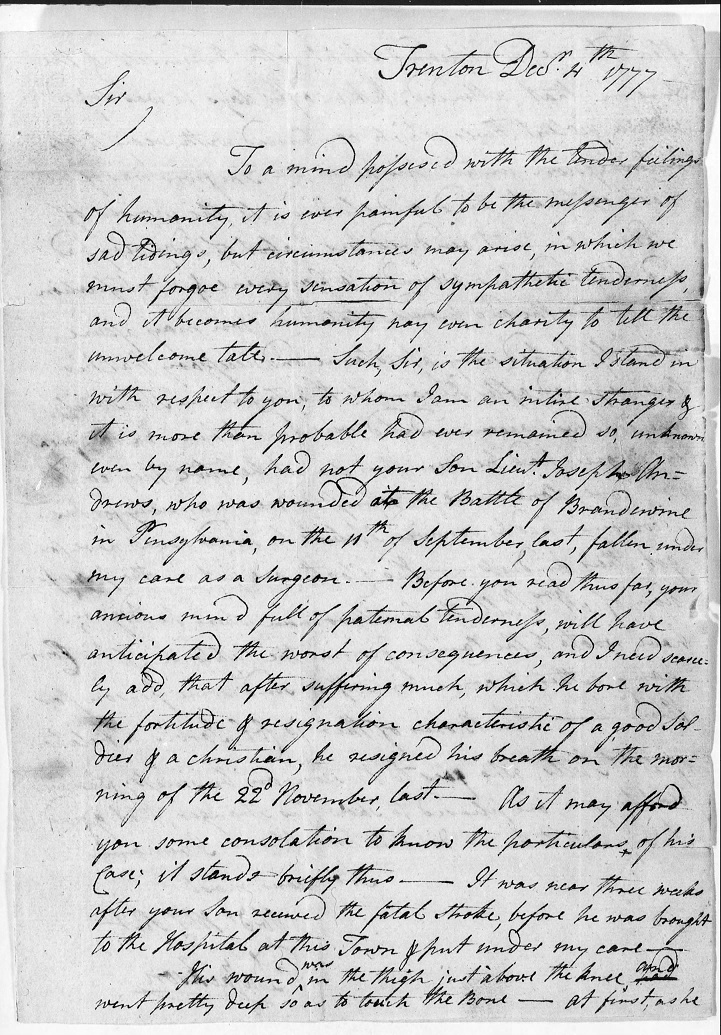
The original December 4, 1777 letter from Doctor David Jackson of Pennsylvania to the parents
of First Lieutenant Joseph Andrews in Massachusetts [from Federal Bounty Land Warrant 2073-200].
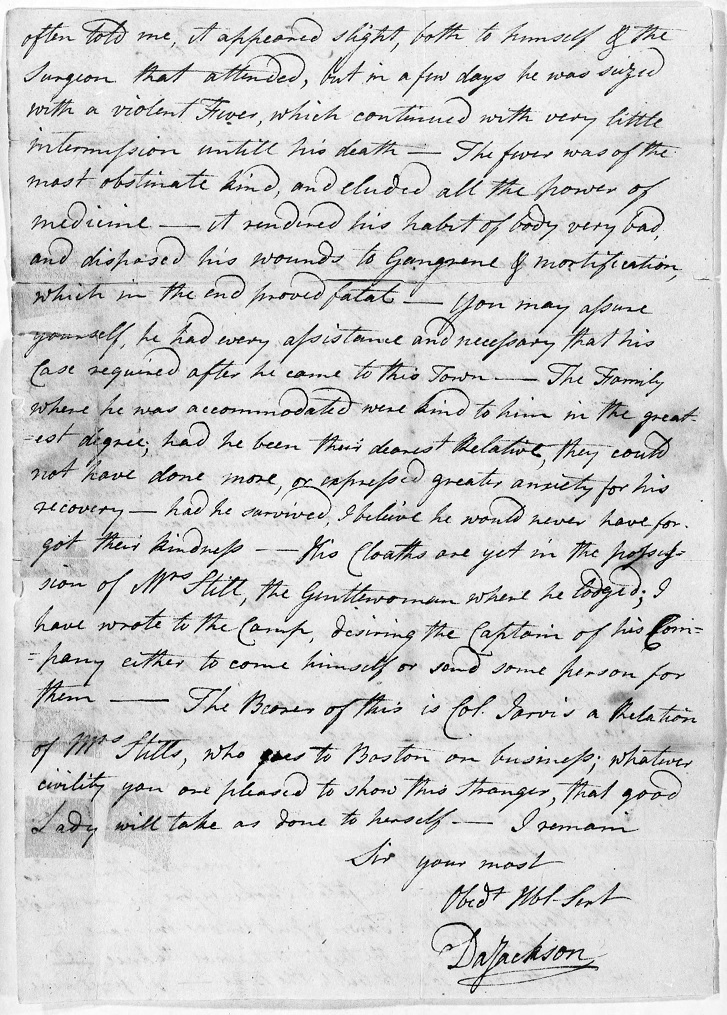
Page 2 of the original December 4, 1777 letter from Doctor David Jackson of Pennsylvania
[from Federal Bounty Land Warrant 2073-200].
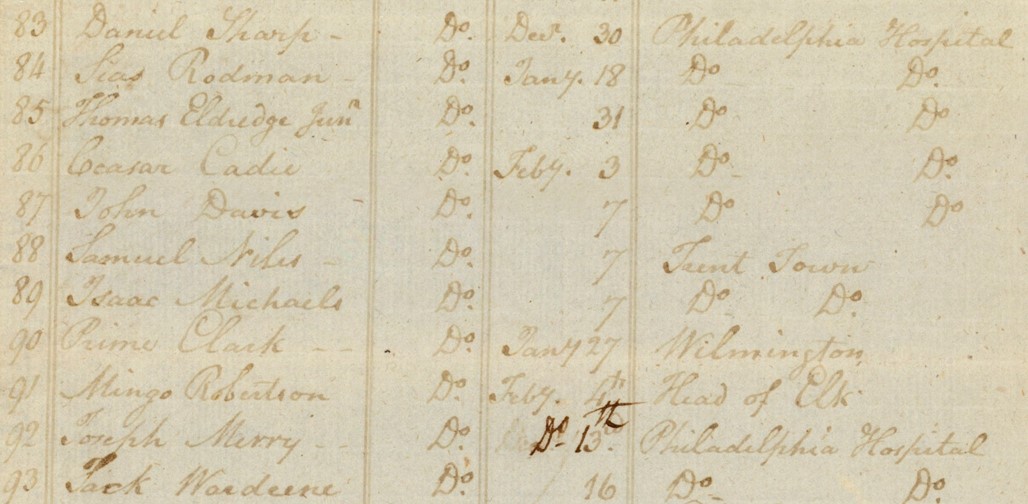
Detail of the Manuscript Document "Return of Non Commissioned officers and Soldiers in the
Rhode Island Regiment who have been killed in Action or Died in Hospital Since the 1st of
October 1781, together with the Names of the places where Such Died," from Rhode Island
Historical Society in Providence, R.I. Note colored Privates Niles and Michaels.
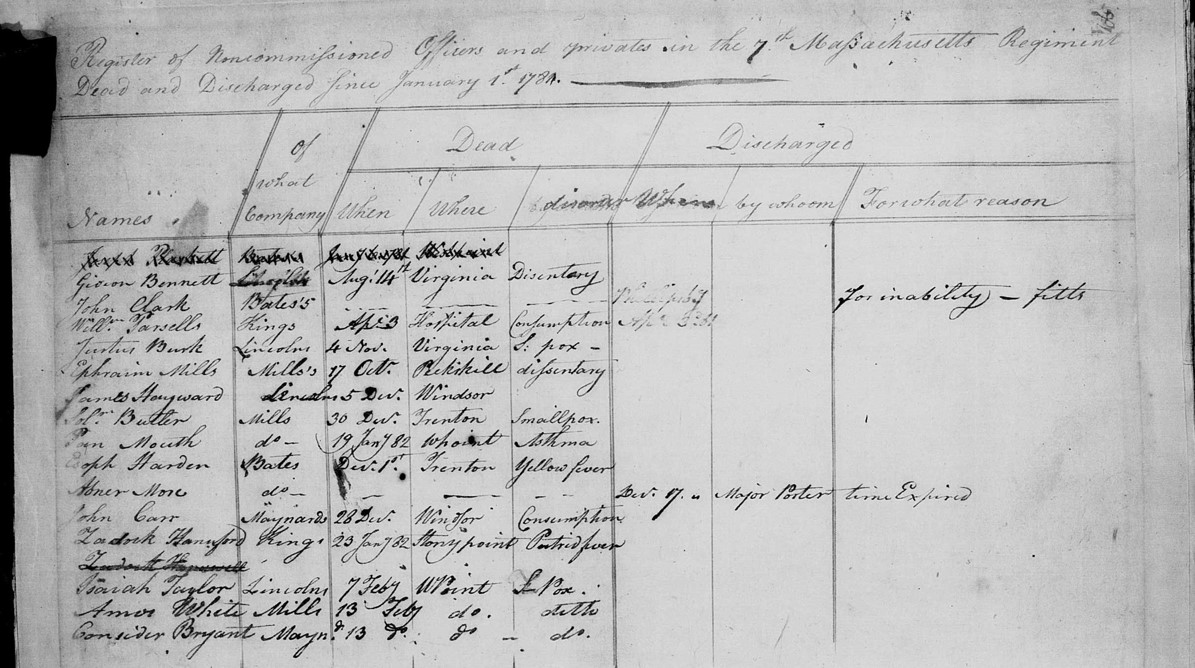
Detail of the Manuscript Document "Register of Noncommissioned Officers and privates in the 7th Massachusetts Regiment
Dead and Discharged since January 1st 1781," courtesy of Massachusetts State Archives, Revolutionary War Rolls, Roll 74,
Regimental Records Book, 7th Massachusetts Continental Regiment. Note Privates Butler and Harden.
Some Historic Maps and modern photos of interest from Trenton, New Jersey (all landscape photos are copyright of Daniel M. Popek)

Detail of Hessian Lt Andreas Wiederholdt's map of the Battle of Trenton in late December
1776. Notice Andreas shows some land free of marshes south and southwest of the
Trenton Barracks site. Map from U.S. Library of Congress.

Map of Trenton, New Jersey in 1835 from Rutgers University Collection. Note
the Water Race-way constructed to power mills south of the State House.

Detail of Trenton, New Jersey Map in 1849 courtesy of U.S. Library of Congress.
Notice the Fish & Green Lumber Yard and the Water Race-way south of the Trenton
Barracks site.

Figure 1.2 of the Hunter Research, Inc. Report "Petty's Run Archaeological Site:
Iron, Steel, Cotton, and Paper in Historic Trenton," May 2014, page 1-3.
This map shows the site of the Iron and Steel Works in relation to the Trenton
Barracks site. Obviously, there would have been no Continental Soldiers burials
in this area. The spaces to the south and southwest of the Barracks could contain
Continental Soldier burials.

Figure 1.3 of the Hunter Research, Inc. Report "Petty's Run Archaeological Site:
Iron, Steel, Cotton, and Paper in Historic Trenton," May 2014, between pages 1-8
and 1.9. This map shows the archaeological excavations done around the Iron and
Steel Works and the Barracks site with modern streets shown. Note the Water
Race-way ("Trenton Water Power"), the excavation of which would have removed any
human burials. However, there is space available for human burials just to the
north, south, and southwest of the Water Race-way.

Detail of Figure 3.4 of the Hunter Research, Inc. Report "Petty's Run Archaeological
Site: Iron, Steel, Cotton, and Paper in Historic Trenton," May 2014, between pages 3-6
and 3.7 illustrating the road network around Trenton in the late 1700s.

Detail of Figure 5.3 of the Hunter Research, Inc. Report "Petty's Run Archaeological
Site: Iron, Steel, Cotton, and Paper in Historic Trenton," May 2014, page 5-14.
This map shows the historic Pettys Run in relation to the modern Trenton footprint.
A culvert was constructed in the subsurface beginning in the late 1800s to channelize
Pettys Run.

Figure 8.1 of the Hunter Research, Inc. Report "Petty's Run Archaeological
Site: Iron, Steel, Cotton, and Paper in Historic Trenton," May 2014, page 8-6.
This proposed view to the south of the Barracks and Steel Works about 1765 may
not have the marsh boundaries correct. Hessian Lieutenant Wiederholdt's 1776 map of
Trenton showed more solid land to the south of the Barracks where Continental
soldiers could have been buried in unmarked graves.

Figure 8.8 of the Hunter Research, Inc. Report "Petty's Run Archaeological
Site: Iron, Steel, Cotton, and Paper in Historic Trenton," May 2014, page 8-25.
Interpretation of the same area in about 1850.

Satellite Photo of Trenton Barracks area about year 2019 from Google Maps.
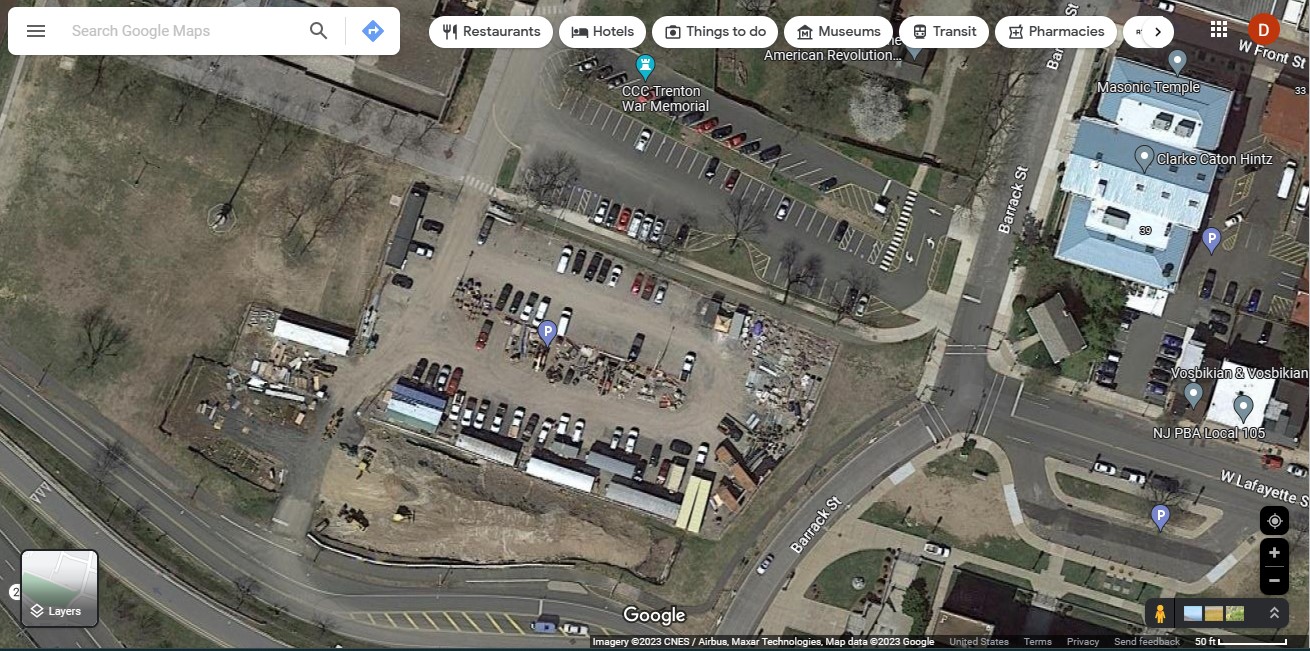
Detail of same area in 2021 when the area south of the parking lot was being used
as a construction staging area for the Renovation of the New Jersey State House.
Note the bulldozers grading at the bottom of the staging area [from Google Maps].
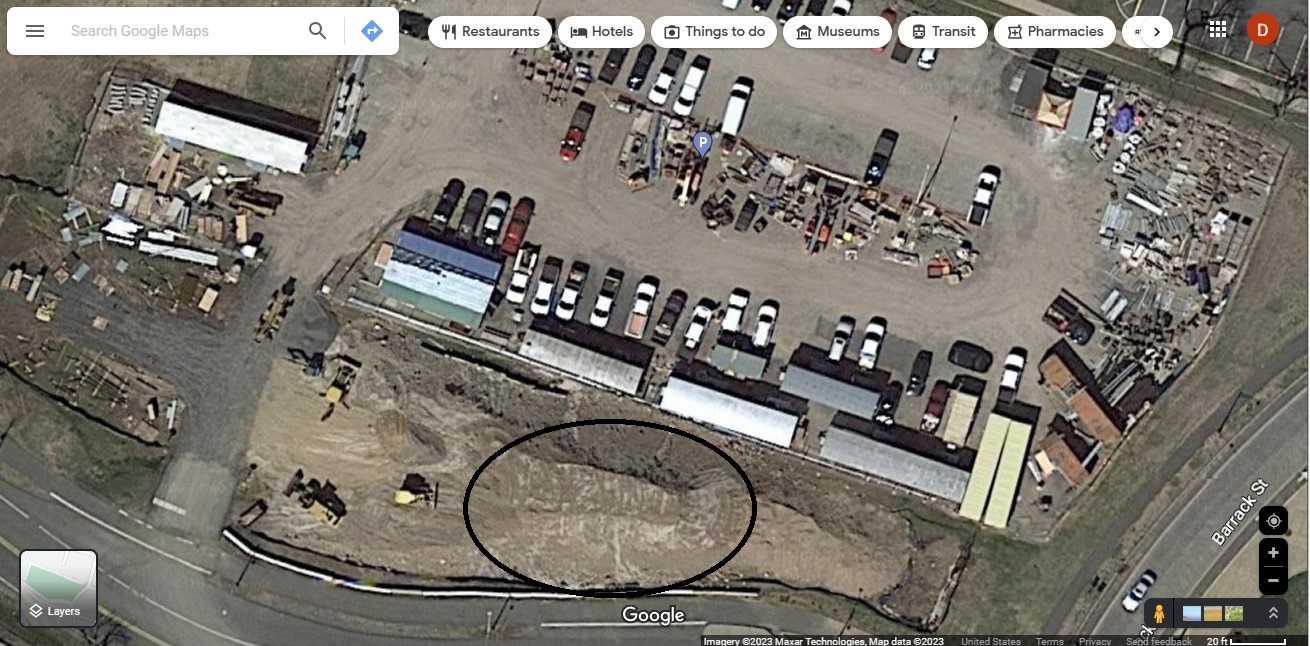
Close-up view of the same area in 2021. Did the bulldozers uncover an
interesting archaeological site in the black circle area?
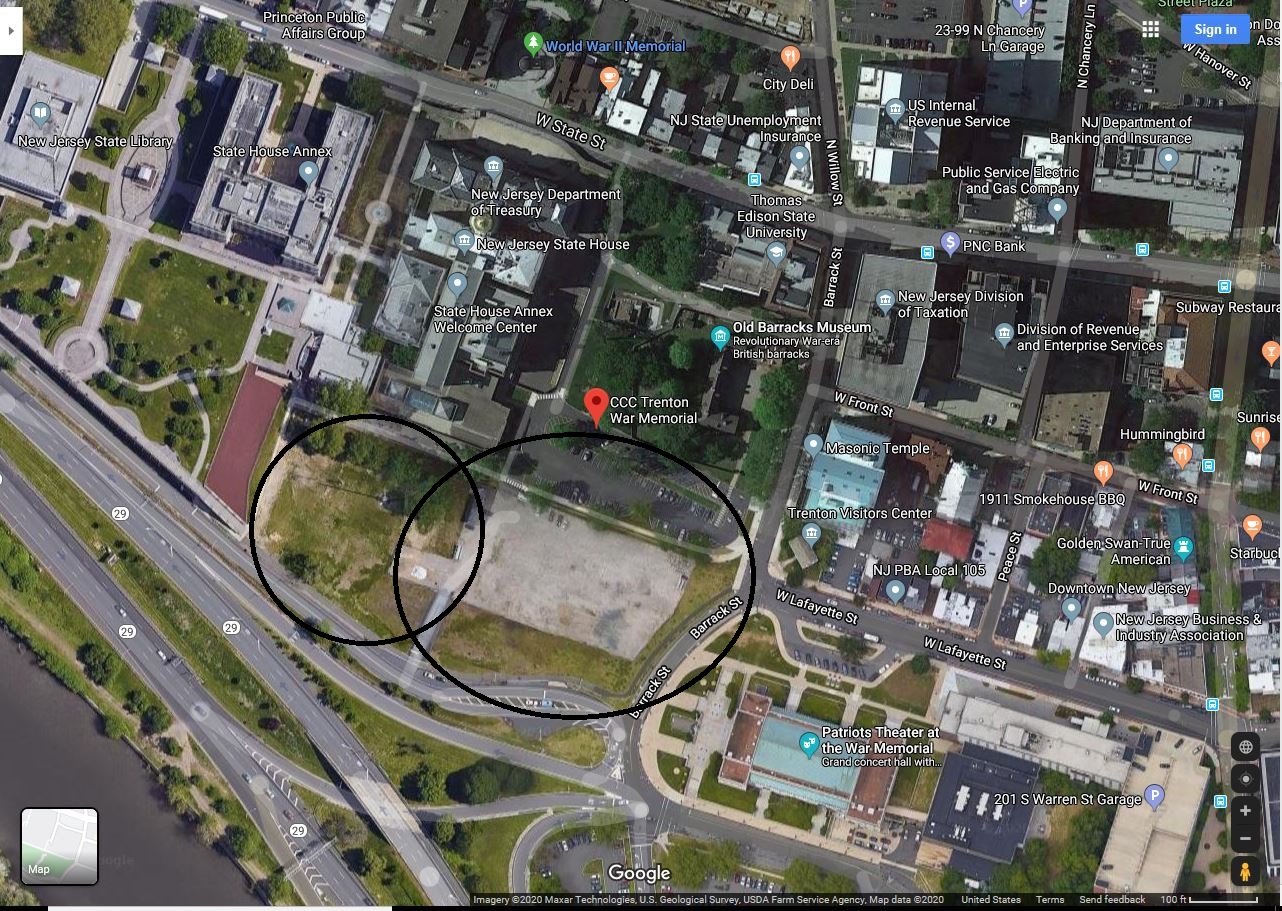
The circled areas are where an Enhanced Victim Recovery [Cadaver] Dog Search should be performed followed up
with Ground Penetrating Radar surveys [from Google Maps]. The New Jersey State Police K9 Search in May 2023
stayed strictly south of the northern parking lot just south of the Barracks Site.

2020 Mercer County GIS Property Map of the Trenton Barracks area. Property "2001" which
includes the search area is owned entirely by the State of New Jersey.
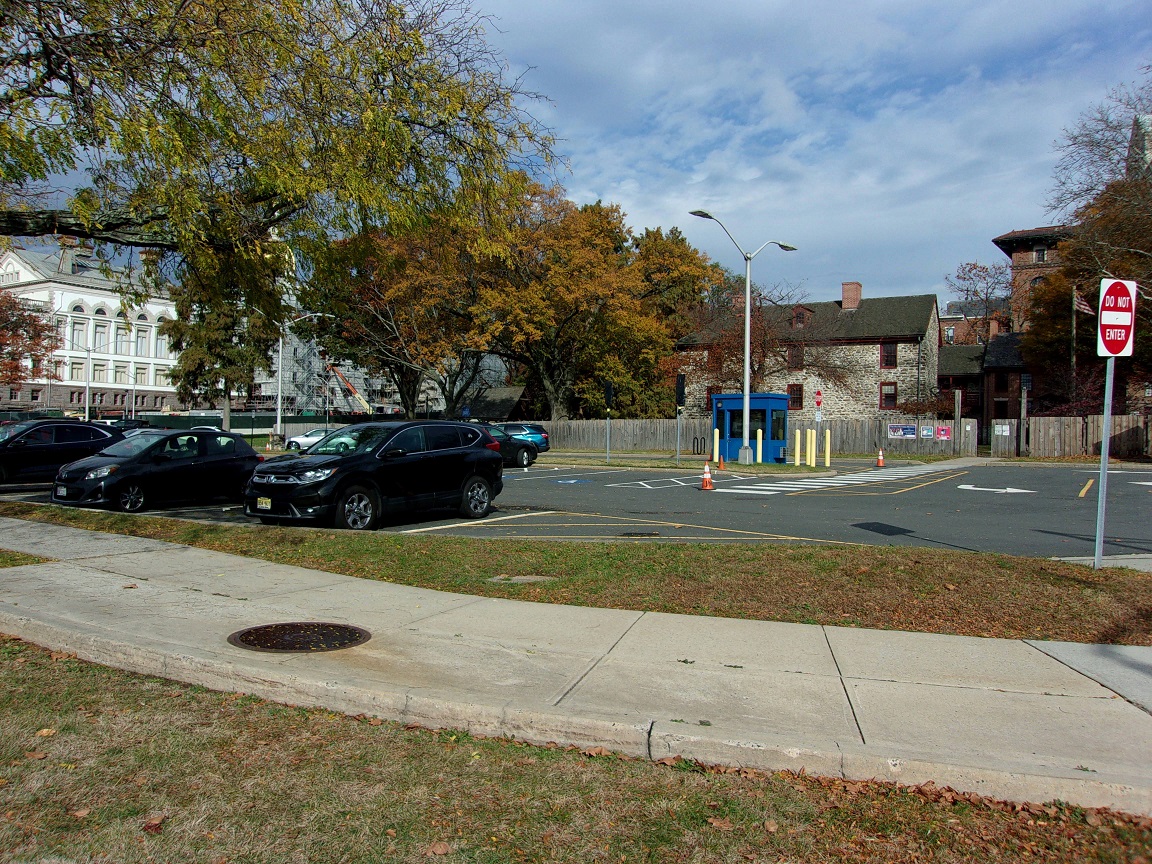
November 13, 2021 view from the parking lot to the north towards the Trenton Barracks. The
New Jersey State House [being renovated] is at the upper left. Note the lighting poles, blue
parking employee box, and the manhole cover. The manhole cover indicates that there are deep
concrete drain pipes probably running west/east tying into the Pettys Run Culvert. This area
would have had some deep excavation for the concrete drain pipes and some shallow excavation
for electrical conduits for the lighting poles and the blue parking employee box. A portion
of this area in the foreground was cut by the water race-way in the mid 1800s to early 1900s
which would have had a deep excavation.
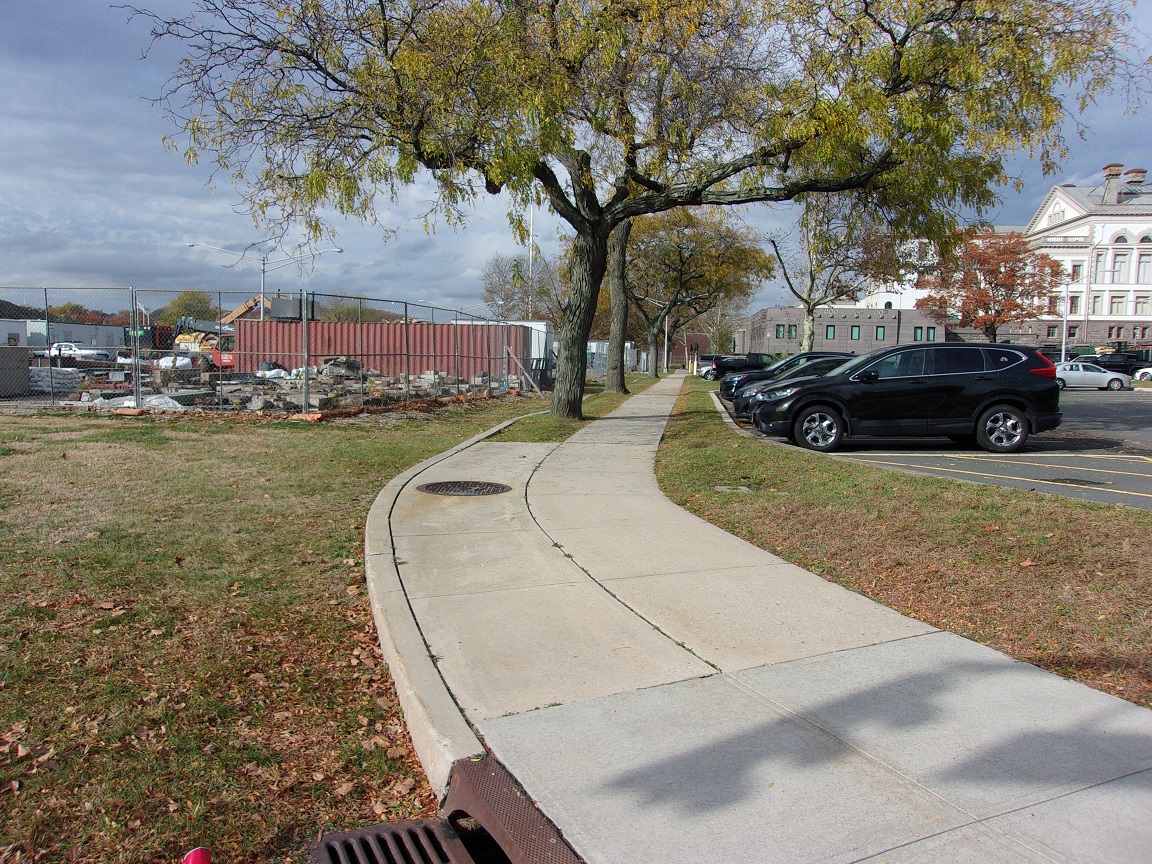
November 13, 2021 view to the west from the same location as the previous photo. The temporary
construction staging area for the New Jersey State House Renovation is to the left. This view
looks down the approximate location of the mid 1800s to early 1900s water race-way.
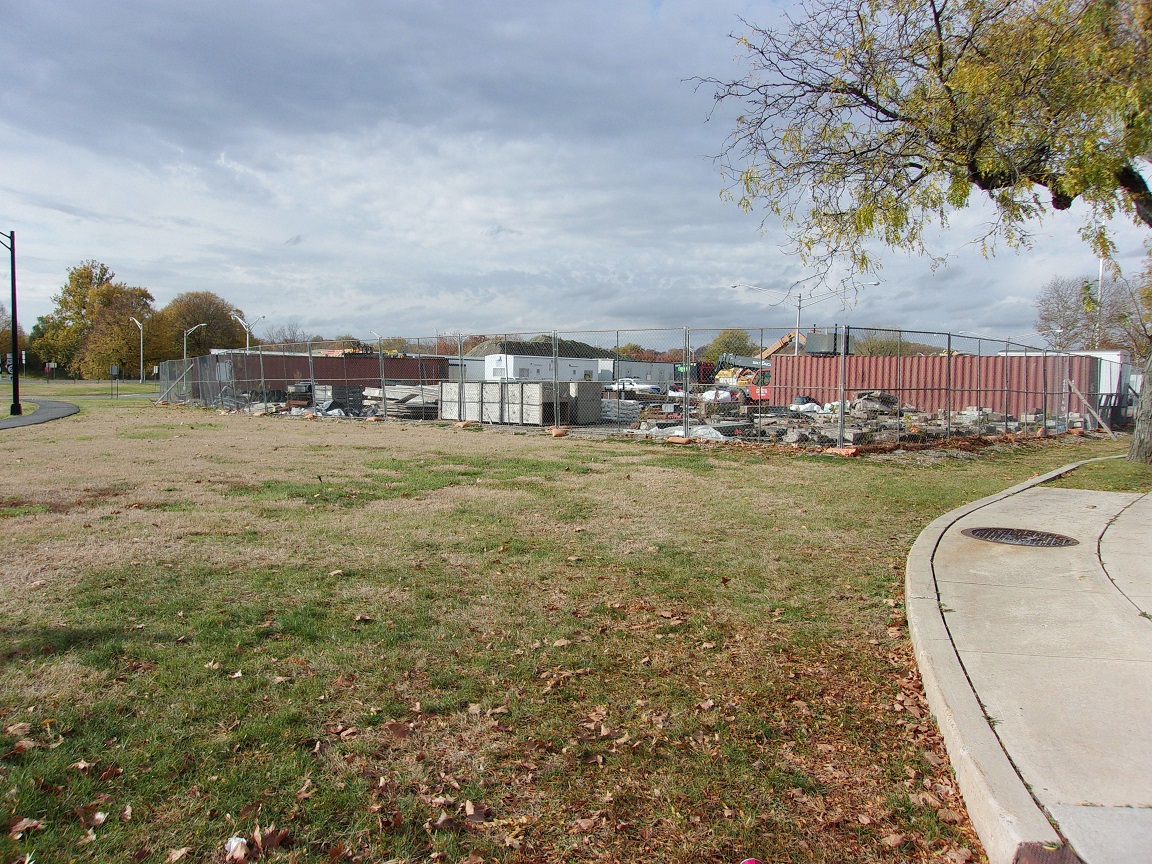
November 13, 2021 view to the southwest from the same location as the previous photo.
Note the soil spoil pile at the back of the fence which made a good observation point.
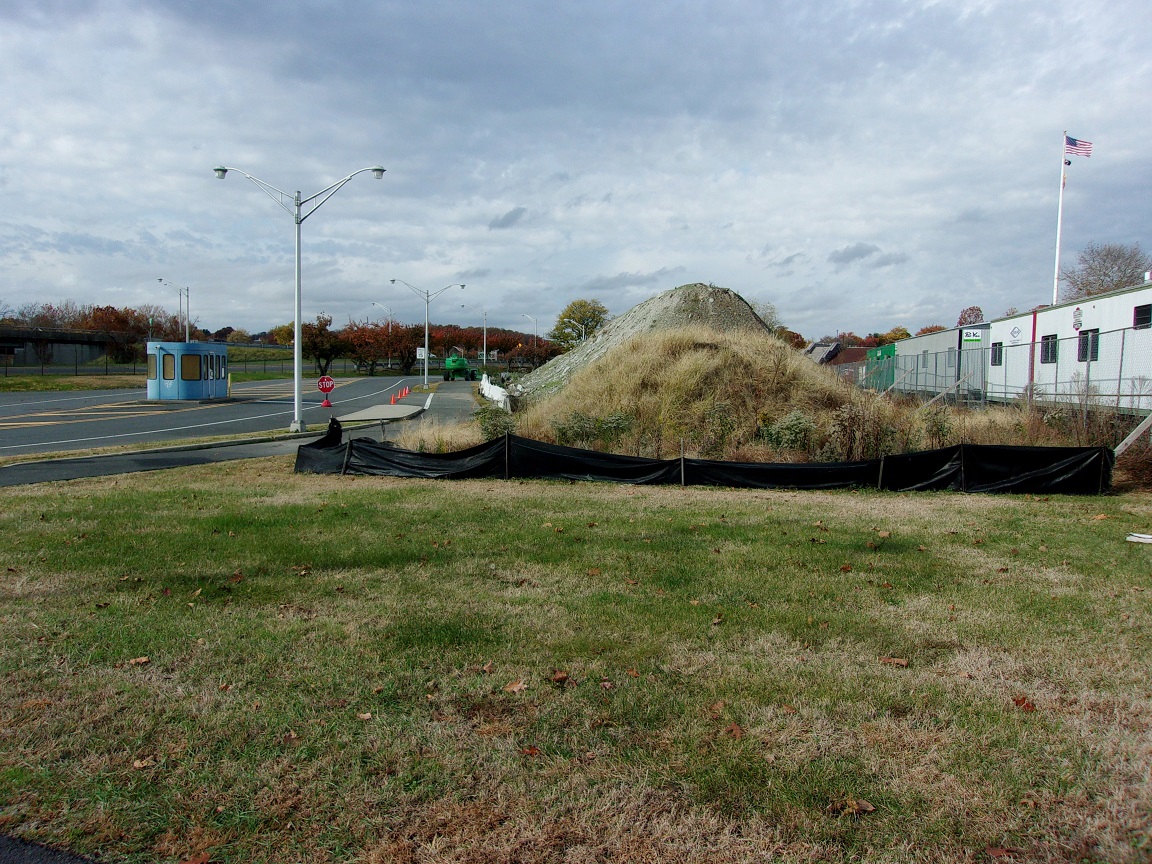
November 13, 2021 view to west of the south end of the temporary construction staging
area and the temporary soil spoil pile [this soil will likely be graded back to the
right after the construction staging area is vacated].
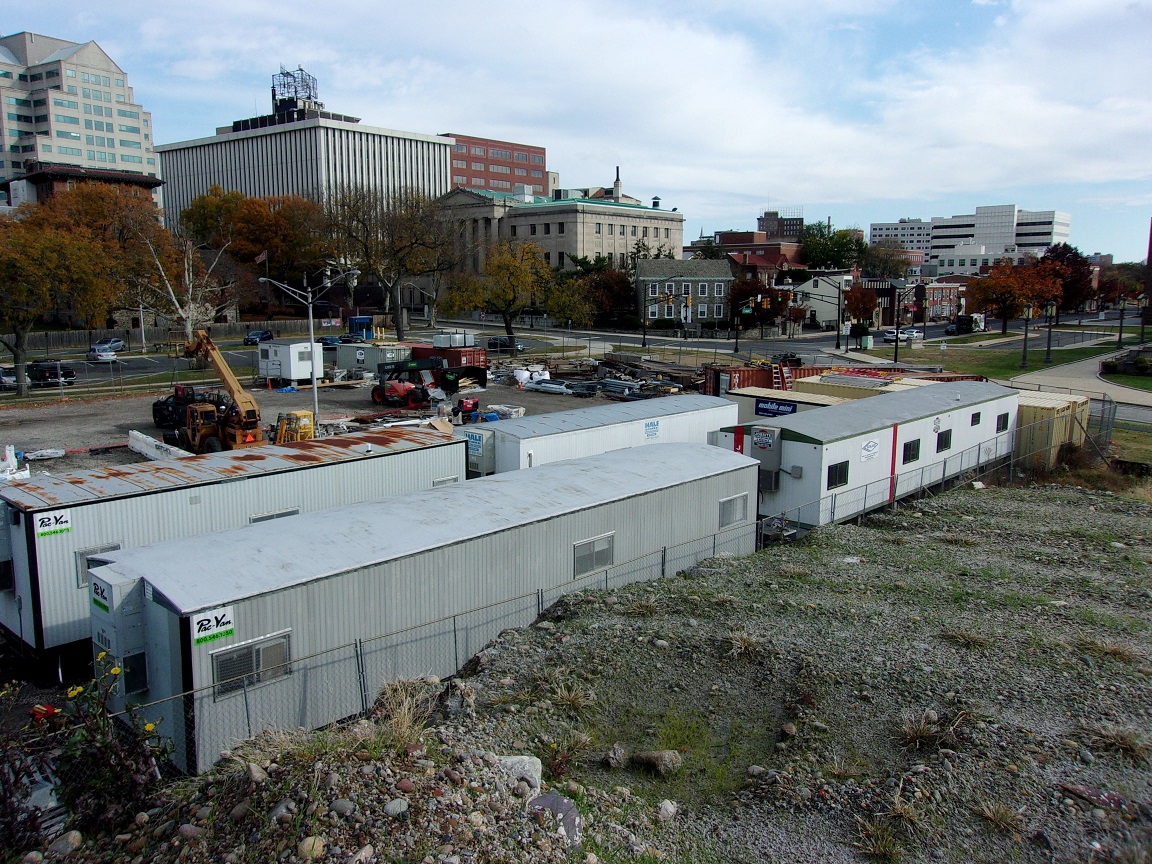
November 13, 2021 view to northeast from top of temporary soil spoil pile.
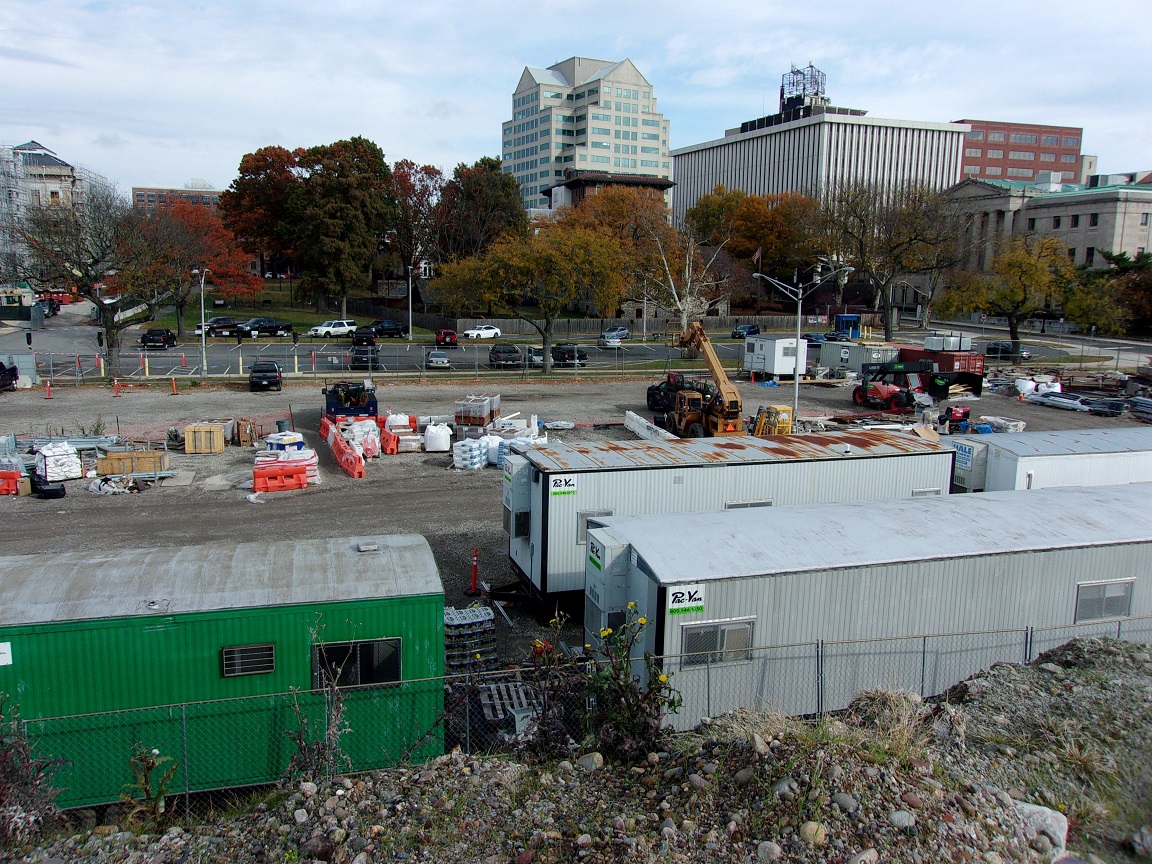
November 13, 2021 view to north from top of temporary soil spoil pile towards Trenton
Barracks with wooden perimeter fence and the Pettys Run Steel and Mill Archaeological
site just to the left of the Barracks perimeter fence.

November 13, 2021 view to northwest from top of temporary soil spoil pile towards
New Jersey State House.
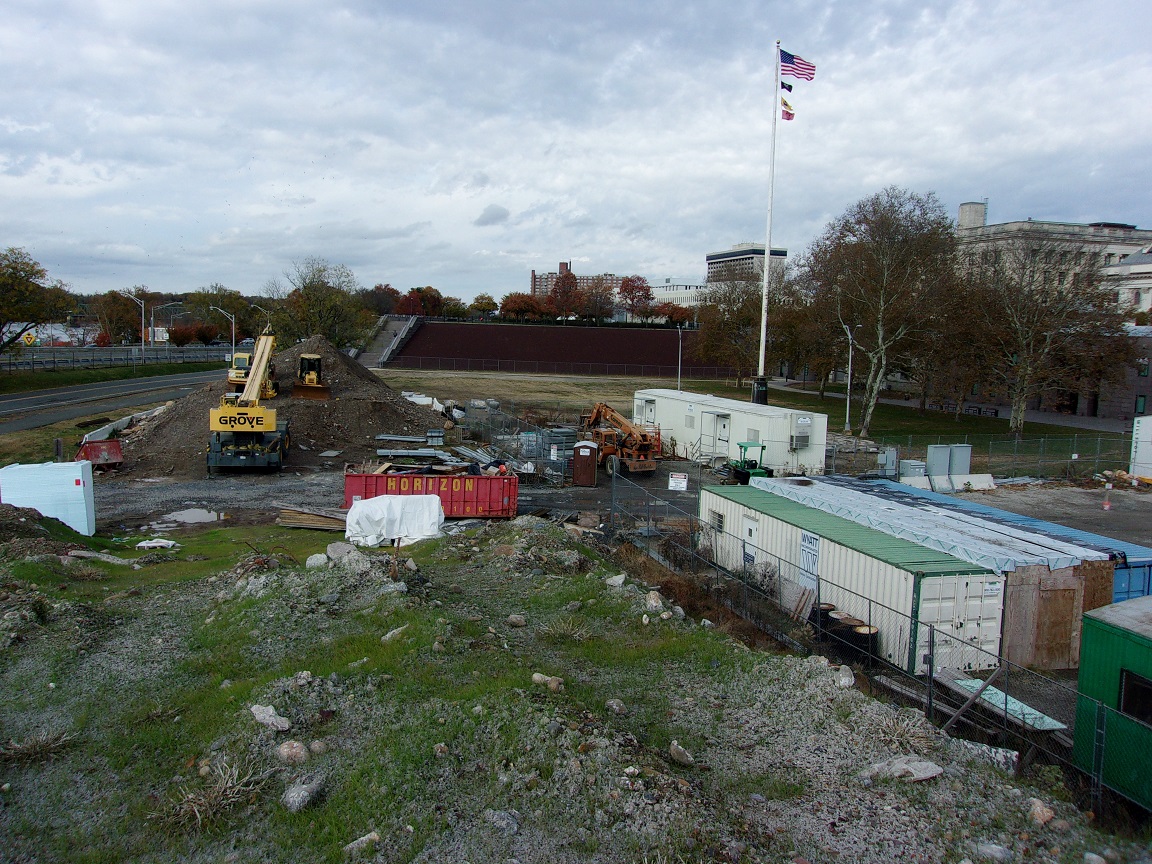
November 13, 2021 view to west from top of first temporary soil spoil pile towards
a second smaller temporary soil spoil pile.
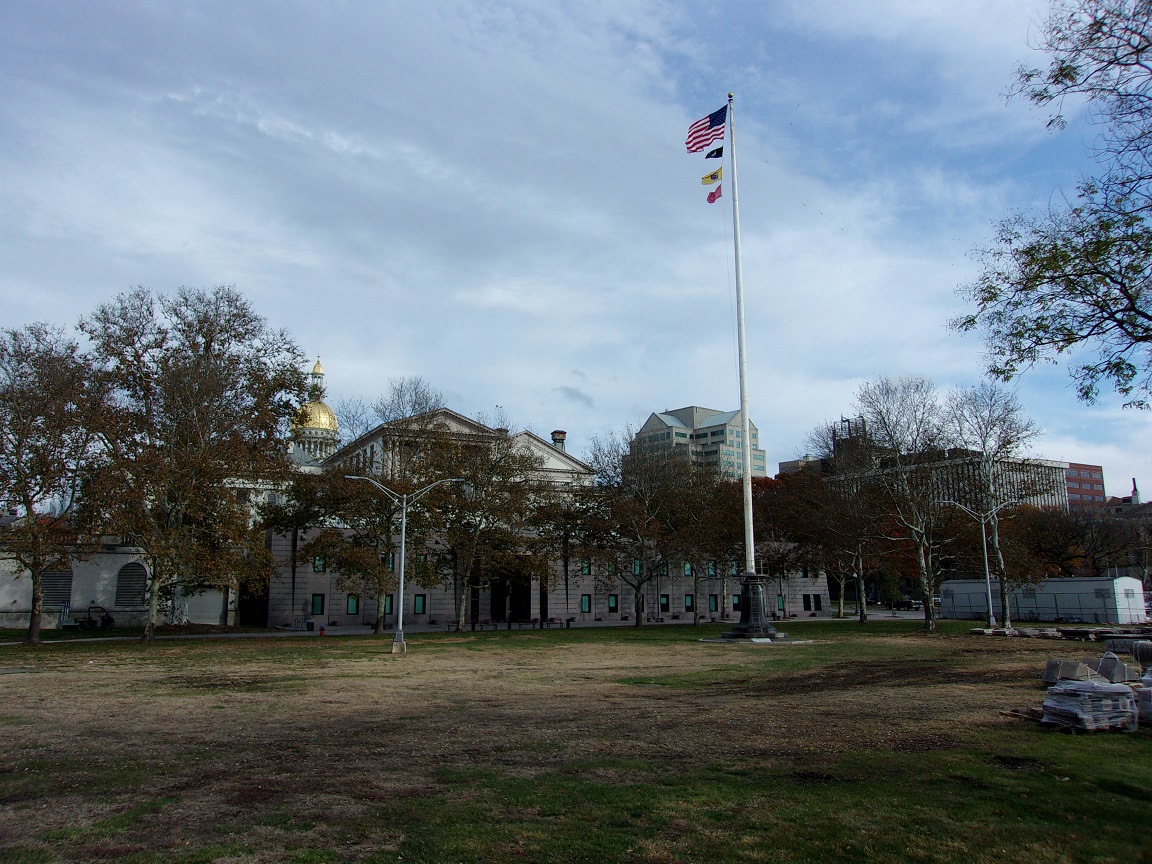
November 13, 2021 view to northeast towards the 1931 Flagpole Monument. This area
was searched by a New Jersey State Police K9 Team in May 2023 with no cadaver dog indications
of remains.

Late 2023 Google Satellite Map of the new parking lot area to the northeast and fields to
the south which appear to be going to be used as a secondary parking area [note the light
poles]. The area south of the black security posts and treeline was searched by a New Jersey
State Police K9 Team in May 2023 with no cadaver dog indications of human remains. However,
the new parking area to the north has not been searched by a cadaver dog team yet.
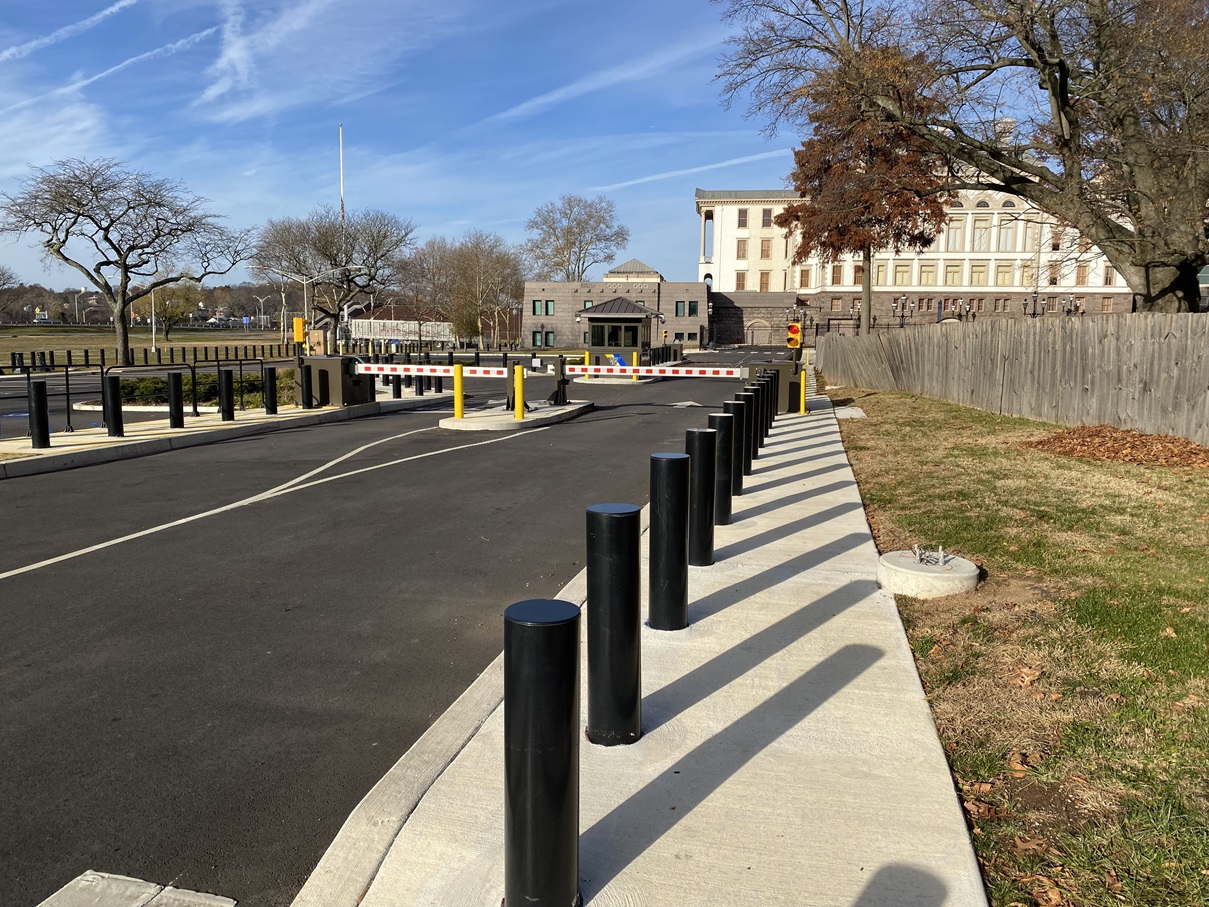
November 25, 2023 view to the west of the new parking lot just south of the Trenton Barracks site.
Clearly, there are new underground electrical conduits that have been constructed to support the lights
and new gates. However, it is possible Revolutionary War burials may exist under the parking lot area.

November 25, 2023 view to the southwest of the new parking lot area just south of the Trenton
Barracks site. The second sidewalk with adjacent trees running to the west marks the approximate
location of an old canal from the 1800s and early 1900s which the excavation of would have removed
any Revolutionary War graves. The open area behind the first sidewalk and the apparent concrete
light base [to the left of the black security posts] could be used to erect new monuments for
documented Continental soldiers who died here at the Trenton Barracks site.
A Couple of Arguments for Soldier Burials outside of established Church Cemeteries in Trenton, New Jersey
1. Most of the American Continental Army soldiers listed on this web page died of smallpox and/or putrid fever. By 1781,
there were strict quarantine procedures for smallpox to protect the civilian population. Does it seem logical for strange
out-of-state military soldiers who died of dangerous, infectious diseases to be transported through the Town of Trenton a
few blocks to be buried in a church cemetery? It would have been much easier to bury the deceased sick soldiers in the
back area of the Trenton Barracks towards the Delaware River and away from Trenton. A good case can be made for First
Lieutenant Joseph Andrews [who was recuperating in a civilian house and died of battle wounds] being buried in a Trenton
church cemetery since he was a Continental Officer, but enlisted men usually weren't given this honor. I have found no
historical evidence to date for a Strangers Burial Ground in Trenton which was much smaller than Wilmington, Delaware and
Philadelphia that had large documented Strangers Burial Grounds.
2. Four of the known American Continental Army soldiers who died were men of color. Does it seem likely strange
out-of-state soldiers of color who died of infectious diseases would have been buried in established Church Cemeteries
in 18th Century Trenton? The Trenton Quaker Cemetery in particular would likely have been off-limits to American soldiers
given the strong anti-war sentiments of the Quaker religion at that time period.
Proposed Cadaver Dog Search and Ground Penetrating Radar Survey
A New Jersey State Police K9 Team searched the entire area south of the northern parking lot [just south
of the Trenton Barracks site] in May 2023 (but did not search the new northern parking lot area). Special thanks
to Lieutenant Bryan, Trooper Matthew, and K9 Faith of the New Jersey State Police Special Operations Section,
Canine Response and Training Unit for conducting the search. Police K9 search dogs are multi-discipline, seeking
explosives, drugs, chemicals, human remains. Enhanced Victim Recovery [Cadaver] Dogs who specialize only on human
remains detection are thought to have superior sensory skills than Police Search Dogs (see an online article on
Enhanced Victim Recovery Dogs here).
It would not hurt to do an additional Enhanced Victim Recovery [Cadaver] Dog search of all of the current paved
parking lot areas just south of the Barracks Wooden Perimeter Fence [and the grass area west of the Barracks fence].
Both 2D and 3D Array Ground Penetrating Radar Grid Surveys should also be conducted in the same large search area.
These geophysical surveys would cost some money, so I need American Citizens to send in emails of support for the
Ground Penetrating Radar surveys to New Jersey State Government Officials (particularly New Jersey State Archaeologist
Dr. Gregory D. Lattanzi [email: Gregory.Lattanzi@sos.nj.gov]) to get these investigations started. Also, New Jersey
State citizens can send in emails of support for both Ground Penetrating Radar Surveys and monuments for known deceased
American soldiers at Trenton to the New Jersey Historical Commission here.
Remember, King Richard III of England was found buried under a parking lot in Leicester, United Kingdom in September 2012
after good historical research and a Ground Penetrating Radar Survey. The American Continental heroes listed on this page
who sacrificed their lives for all Americans should be given U.S. Department of Veterans Affairs Monuments [at a minimum]
that they are already legally ENTITLED TO. Plenty of open space is available at the Trenton Barracks site or in the area on
New Jersey State property to the southwest. I would like to point out to New Jersey Officials that Federal Funding is also
available through the National Park Service American Battlefield Protection Program [https://www.nps.gov/orgs/2287/index.htm].
SOURCES
James E. Gibson, "Dr. Bodo Otto and the Medical Background of the American Revolution," Coastal Printing,
Sarasota, Florida, 1937.
Mary Caperton Gillett, Ph.D., "The Army Medical Department 1775 to 1818," U.S. Army Center of Military
History, U.S. Government Printing Office, 1981.
Hunter Research, Inc. Report "Petty's Run Archaeological Site: Iron, Steel, Cotton, and Paper in Historic
Trenton," May 2014.
Paul S. Martin, "Geophysics to Cadaver Dogs: Multi-Method Approach to Surveying Historical Cemeteries,"
Geological Society of America Southeastern Section Meeting, Charleston, South Carolina, 2019.
Daniel M. Popek, They "...fought bravely, but were unfortunate...," The True Story of Rhode Island's
"Black Regiment" and the Failure of Segregation in Rhode Island's Continental Line, 1777 - 1783, AuthorHouse, 2015.
[my own book which covers the colored and white soldiers of Rhode Island's Continental Line in a balanced and
accurate account].
John U. Rees, " 'Their presence Here ... Has Saved this State...' Continental Provisional Battalions
with Lafayette in Virginia, 1781, Part 1," The Brigade Dispatch XXXVI, no. 3 (Autumn 2006): 2-23.
John U. Rees, " 'Their presence Here ... Has Saved this State...' Continental Provisional Battalions
with Lafayette in Virginia, 1781, Part 2," The Brigade Dispatch XXXVII, no. 2 (Summer 2007): 2-18.
John U. Rees, " 'Their presence Here ... Has Saved this State...' Continental Provisional Battalions
with Lafayette in Virginia, 1781, Part 3," The Brigade Dispatch XXXVII, no. 4 (Winter 2007): 2-15.
John U. Rees, "Barber's Light Battalion, 1781 (New Jersey Light Company Personnel)" [transcript by John
of manuscript Light Company returns he found in the New Jersey State Archives Revolutionary War Collection].
"Return of Non Commissioned officers and Soldiers in the Rhode Island Regiment who have been killed in
Action or Died in Hospital Since the 1st of October 1781, together with the Names of the places where
Such Died," Manuscript Document, Rhode Island Historical Society Manuscripts Collection, Providence,
Rhode Island.
Massachusetts Revolutionary War Rolls, Microfilm, Massachusetts State Archives.
U.S. National Archives Microfilm M246, "Revolutionary War Rolls, 1775-1783" (Original Muster Rolls - -
various Continental Army Regiments from 1781 and 1782).
Born in Providence, Rhode Island, Daniel M. Popek is a descendant through his mother's family of a soldier who served
six years in Rhode Island's Continental Line, including the integrated Rhode Island Regiment (Continental) of 1781-1783.
Daniel is an Engineering Geologist/Geotechnical Engineer in North Carolina. He is a member of the Rhode Island Genealogical
Society, and the New England Historic Genealogical Society of Boston, Massachusetts. Daniel is the son of a career Active Duty
U.S. Army Officer (Retired), and the grandson of a U.S. Marine Combat Infantryman of World War II (Third Marine Division).
Daniel has lived in several states in the eastern U.S. during his life including Maryland and Pennsylvania.
If you have comments or can provide additional information on any historical or archaeological issues,
then please send me (Dan) an email.

























